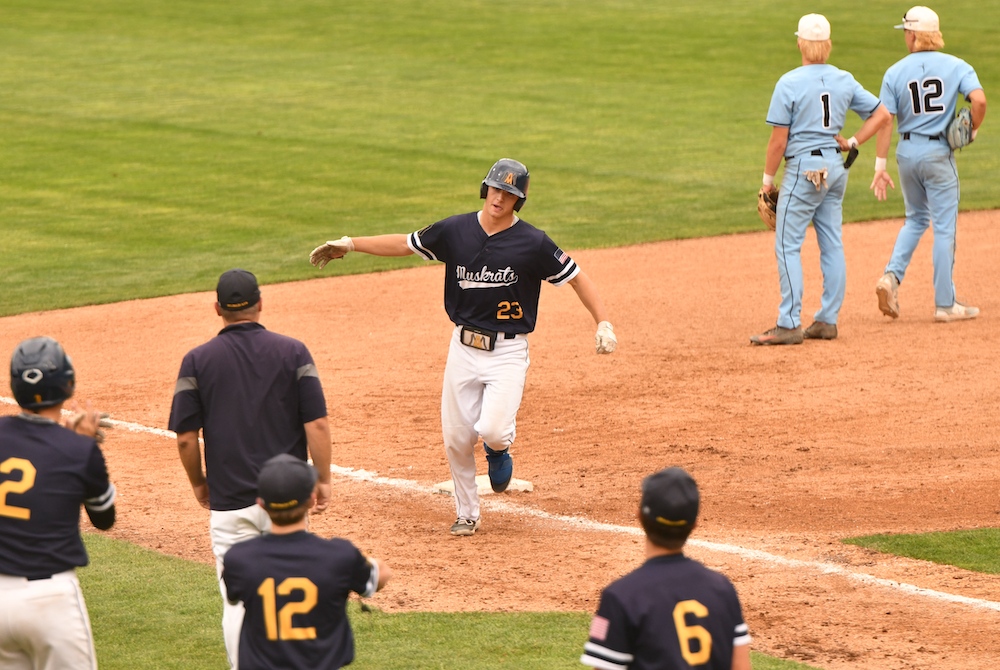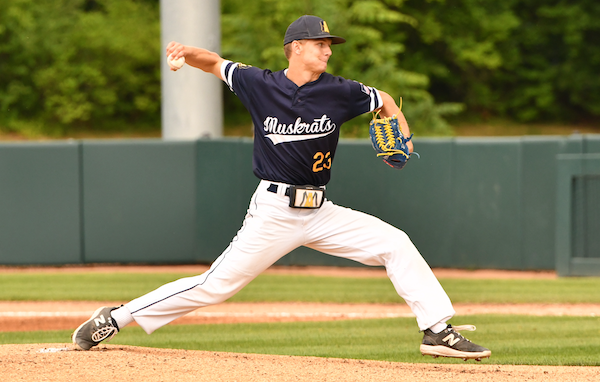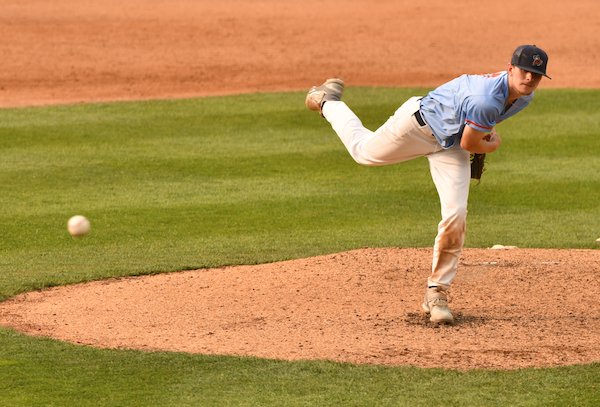
1971: MHSAA Launches 'Big One' for Baseball
June 13, 2016
By Ron Pesch
Special for Second Half
“It’s a big one,” said state director of athletics Al Bush, when asked about organizing the Michigan High School Athletic Association’s inaugural baseball tournament back in January 1971. “The idea has been under study for more than three years.”
After discussions with the MHSAA Representative Council, in mid-December a committee of seven coaches from various parts of the state gathered and built the framework for the tournament, according to Associated Press reports.
Still ranked among the Top 10 all-time fall classics, the Detroit Tigers’ 1968 World Series victory over the St. Louis Cardinals meant interest in the national pastime was on the rise in Michigan.
Bush noted that about 650 Michigan high schools had sponsored baseball in 1970, and that plans for organizing the pending tournament were much like those for basketball, with Districts and Regionals. Circulars sent out by the MHSAA asking about planned participation indicated nearly 500 schools intended to play in the tournament. As in other sports, except basketball, plans were to host separate tournaments for the Upper and Lower Peninsula due to weather conditions experienced above the Mackinac Bridge.
While a number of cities in the past had hosted baseball tournaments where schools from around the state had been invited to participate, the MHSAA had never previously sponsored a statewide tournament. Perhaps the most well-known was one hosted in Battle Creek for about 10 seasons in the 1940s and 1950s.
In April 1971, Districts were announced, with qualifying round play scheduled for May 17-27 and Pre-District contests planned for May 29 that would allow the field of teams to be cut to four for the Districts. A total of 594 teams entered the Lower Peninsula tournament. The Finals for all classes were scheduled for June 19.
“I think you could draw it out of a hat and call a certain team a favorite, and you’d be correct,” said MHSAA Associate Director Vern Norris 45 years ago when discussing the uncharted territory of that first tournament. “There’s just no basis for comparison. I think we can say the teams competing Saturday are the cream of the crop, although in any tourney competition some good teams are eliminated early.”
“Overall, we’ve been very pleased,” he continued. “No. There haven’t been any major problems. The umpiring has been good and the support from the schools excellent. The person who really helped us out was the weatherman.”
 All 48 Regional games were played without a hitch. In years past (and in years to come), weather had played havoc with previous tournaments.
All 48 Regional games were played without a hitch. In years past (and in years to come), weather had played havoc with previous tournaments.
Four sites were used for the games. Class A was played at Wyandotte Memorial Field, while Class B was hosted at Battle Creek Central. Class C contests were scheduled at Marshall High School with Class D at Central Michigan University’s Alumni Field in Mount Pleasant. Semifinal games were scheduled for 10 a.m. and 12:30 p.m., with finals scheduled at 3:30 p.m. at each location.
The Detroit area emerged with three of the four titles, with games played beneath hot and humid weather.
Jim Saad, recruited to Colorado State to play football, smacked a 355-foot two-run homer to left field in the opening inning of the Finals as Harper Woods Bishop Gallagher blanked Royal Oak Kimball 3-0 before 1,200 fans for the Class A crown. Greg Boos tossed a two-hitter for the Lancers, striking out 10 along the way. It was the first of three Class A baseball titles won by Gallagher and their coach Jim Bresciami, who would lead his teams to 545 wins between 1965 and 1985. The Detroit Catholic League’s First Division East champion, Gallagher finished with a 32-5 record on the year. Right-hander Boos ended the season with an 11-2 mark.
Detroit Lutheran West posted 24 wins against a single defeat, scoring a 4-1 win over Pinconning for the Class B title. A bases-loaded single by Fred Schebor in the fifth inning brought in two runs to break open a 1-1 tie. Bill Lindblom was responsible for West’s other two runs, driving in runners with a single in the second inning and a double in the sixth. Junior Leon Druckenmiller struck out six and scattered six hits for the Leopards for the win. Earlier in the day, John Paloni struck out 18 batters in West’s 3-0 Semifinal win over Wayland.
Hamtramck St. Ladislaus took advantage of a pair of third inning errors, scoring two runs in the team’s 3-0 win over Dearborn Sacred Heart. Tom Crepeau pitched a four-hitter and struck out seven, while Paul Janas led the victors with two singles and a double in the Final. The win avenged a pair of nonleague losses to Sacred Heart during the regular season. Rick Radzinski pitched a two-hitter and drove in three runs in Ladislaus’ 7-1 Semifinal win over Sanford-Meridian.
Managed by 1952 alumnus Jim Powell, Mount Pleasant Sacred Heart rebounded from an early 8-1 deficit in its Semifinal game with Marion for a 16-12 win, gaining a birth in the Class D championship game against Portland St. Patrick. The Irish’s Roger Therman then pitched a four-hitter in a 5-1 win over St. Patrick.
To the north, with its later thaw, the high school baseball season continued to revolve around summer American Legion baseball but also two U.P. high school leagues: the Eastern Upper Peninsula High School Baseball League (EUP) and Western Upper Peninsula High School Baseball League (WUP). In its 14th year of operation, the WUP saw Ironwood post an 11-1 record against six league opponents to earn the 1971 league championship, while Rudyard repeated as champs with a 12-4 season in the nine-team EUP.
Today, the U.P.’s most famous baseball player remains Kevin Tapani, a 1981 graduate of Escanaba, who pitched for 13 years in the Major League. Tapani quarterbacked the Escanaba Eskymos to the MHSAA Class A football title in 1981, yet never threw a pitch for his high school because of the weather.
Forty-five years later, Mother Nature continues to influence baseball in the Upper Peninsula – although over time Upper Peninsula schools began taking part with those from the Lower Peninsula in a statewide MHSAA Tournament. The first U.P. team to make the Semifinals in baseball was Sault Ste. Marie in 1988.
This season, 21 Upper Peninsula schools sponsored varsity baseball teams, as gradually some have brought back programs long in hibernation – Gladstone, for example, made the Division 3 Semifinals in 2014 after bringing back a baseball program the year before that hadn't played since 1959.
 Ron Pesch has taken an active role in researching the history of MHSAA events since 1985 and began writing for MHSAA Finals programs in 1986, adding additional features and "flashbacks" in 1992. He inherited the title of MHSAA historian from the late Dick Kishpaugh following the 1993-94 school year, and resides in Muskegon. Contact him at [email protected] with ideas for historical articles.
Ron Pesch has taken an active role in researching the history of MHSAA events since 1985 and began writing for MHSAA Finals programs in 1986, adding additional features and "flashbacks" in 1992. He inherited the title of MHSAA historian from the late Dick Kishpaugh following the 1993-94 school year, and resides in Muskegon. Contact him at [email protected] with ideas for historical articles.
PHOTOS: (Top) Detroit Lutheran West stands together for a team photo; it won the inaugural Class B title. (Middle) Champions of the first MHSAA Tournament, in 1971, included Harper Woods Bishop Gallagher, Hamtramck St. Ladislaus and Mount Pleasant Sacred Heart.

Pitchers Provide Offensive Sparks Too as Algonac, Bridgman Advance
By
Keith Dunlap
Special for MHSAA.com
June 15, 2023
EAST LANSING – For Algonac junior pitcher Josh Kasner, his bat proved to be the perfect medicine for what was ailing him on the mound during a Division 3 Semifinal against Lansing Catholic on Thursday.
Kasner labored through the first three innings of his start, but then new adrenaline on the mound came after what he did at the plate in the bottom of the third inning at Michigan State’s McLane Stadium.
With two outs, two strikes and two men on base, Kasner launched a 3-run home run just to the right of the foul pole.
Kasner settled down on the mound after that, with the home run and his pitching being the difference for Algonac in a 4-1 win over the Cougars that earned the Muskrats their first appearance in a Final at 11:30 a.m. Saturday.
“It was a fastball inside,” Kasner said. “To be honest, I was sitting on fastball and adjusting to off-speed. It was my pitch, and I got it inside the foul pole. I knew that once I got that home run, we were up 3-1, I settled in and I was going to be fine.”
Indeed, as Kasner didn’t allow Lansing Catholic much of a threat after he threw 55 pitches, walked three and hit two batters through the first three innings.
 Over the last four innings, Kasner didn’t walk anybody and allowed only one Lansing Catholic batter to reach second base.
Over the last four innings, Kasner didn’t walk anybody and allowed only one Lansing Catholic batter to reach second base.
“I think he was stressed a little bit,” Algonac head coach Scott Thaler said. “You get to this point, I think the zone is where it should be as opposed to sometimes where it is during the season. He got the idea of what a college zone is like, which should help him out in a couple of years.”
After Kasner’s blast, Algonac added another in the fifth inning when junior Matt Rix reached on a bunt single, stole second, took third on a sacrifice bunt and then scored on a passed ball to give the Muskrats a 4-1 lead.
Lansing Catholic scored first in the top of the third inning, grabbing a 1-0 lead on an RBI single to right with two outs by senior Drew Burlingame. The Cougars later loaded the bases with two outs in the third, but Kasner got out of the jam with a strikeout.
Sophomore Drew Tolfre allowed just four hits in a complete-game effort for Lansing Catholic (23-6.)
“He had two strikes on (Kasner), but he kind of missed his spot a little bit,” Lansing Catholic head coach Randy Farlin said. “But you can’t fault him. He pitched a helluva game. We just didn’t have the bats. One run is not going to do it for us. We just didn’t put it all together today.”
Bridgman 3, Standish-Sterling 2
Bridgman didn’t get a hit until the seventh inning of its Semifinal against Standish-Sterling.
But all Bees (32-9) needed were two hits during that set of at-bats to move on to their first Final since 2011.
With the score tied 2-2 and a runner on second base, freshman Cooper Allwood delivered the game-winning single to left with one out, scoring junior Alec MacMartin to give Bridgman the victory.
MacMartin started the inning with the first hit of the day off of Standish-Sterling sophomore starter Sam Briggs, and then was sacrificed over to second.
“We were just having fun and getting comfortable in the situation,” Allwood said. “Just never giving up. We’ve been in games like this before. Nothing new.”
 After neither team collected a hit through the first three innings, Standish-Sterling got something going in the top of the fourth.
After neither team collected a hit through the first three innings, Standish-Sterling got something going in the top of the fourth.
Junior Cooper Prout led off with a double, and then sophomore pinch runner Brecken Stokoszynski scored on an RBI single by senior Brayden Schabel.
In the bottom of the fourth, Bridgman put runners on second and third with two outs after an error and a hit batter, but a flyout ended the threat.
In the fifth, Standish-Sterling took a 2-0 lead when a fly ball by Briggs just eluded the Bridgman left fielder down the line, scoring sophomore Brock Bartlett.
The Bees answered in the bottom half of the fifth, tying the game at 2-2 without registering a hit thanks in large part to three infield errors by Standish-Sterling.
An RBI groundout by Allwood made it 2-1, and then Bridgman tied the game at 2-2 following another error with a runner on third and two outs.
The score remained that way until Allwood’s single in the seventh.
“We were just missing that timely hit,” Bridgman head coach Justin Hahaj said. “We finally got it.”
MacMartin got the win on the mound for Bridgman, allowing four hits, walking one and striking out six in a complete-game effort.
Briggs lost for the first time this year, striking out eight for Standish-Sterling (29-15), which fell in the Semifinals for the second-straight season.
Standish-Sterling head coach Ryan Raymond said it was more than just four errors that cost his team.
“We didn’t hit in the right spots either,” Raymond said. “We had some opportunities to get some hits and knock some more runs. It’s a team effort.”
PHOTOS (Top) Algonac’s Josh Kasner rounds third base during his home run in Thursday’s Semifinal win over Lansing Catholic. (Middle) Kasner makes his move toward the plate. (Below) Bridgman’s Alec MacMartin delivers a pitch during the day’s last Semifinal. (Photos by John Castine/Hockey Weekly Action Photos.)

